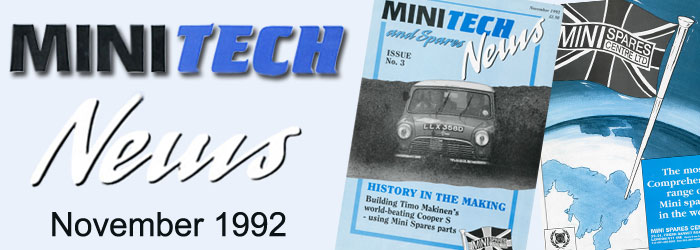Correct sizing of the guide is very important. Not only does the guide support the valve, but also helps dissipate heat from the valve – especially important for the exhaust valve. This particular point is even more critical now that hi-grade fuels are no longer available, worsened by many people converting to lead-free fuel.
Historical Article - Nov 1992 - A Guiding Hand - Do not adjust your seat too much
A question frequently asked by customers buying new valve guides is what size the guide should be reamed to once fitted. The answer initially is easy, 9/32” (.812”). However, nothing in life is simple.
Correct sizing of the guide is very important. Not only does the guide support the valve, but also helps dissipate heat from the valve – especially important for the exhaust valve. This particular point is even more critical now that hi-grade fuels are no longer available, worsened by many people converting to lead-free fuel. The reduction in octane rating and lead means the valves have to deal with increased temperatures, therefore requiring the guides to be more efficient at absorbing heat from the valve stem. If the valve to guide clearance is too large, the heat transfer is greatly reduced. No so much of a problem to the inlets as these are party cooled by the incoming fuel, but a real problem for the exhaust valve. If the exhaust valve gets too hot, it will lead to pre-ignition and detonation which will ultimately damage the pistons severely, not to mention valve seizure.
The 9/32” dimension is fine if new valves are used, as the stems are sized to .279”, giving just over .002” clearance. However, if old valves are used, the stems should be checked for size. If they are worn by more than .0005”, then it is advisable to replace the valves. It is not really possible to size the guides to suit, as the top section of the valve around the collet area does not wear, and trying to size this area down is not really feasible from a cost/reliability point of view.
We have looked at and marketed pre-sized guides that should not need reaming once fitted. These are o.k. providing new valves are used, and the head hasn’t already had several sets of guides fitted. Each time guides are fitted the guide hole is stretched a little more. Apart from not shrinking the guide by a pre-guess amount, they become a looser fit which could lead to the guide slipping down, eventually holding the valve open. Using worn valves in pre-sized guides gives a clearance that is too large, greatly reducing heat transfer and allowing too much oil to pass down between the valve and guide. Excessive oil seepage will also contaminate the incoming charge; therefore reducing its effective octane rating creating unwanted “pinking” – a situation worsened in performance engines with high compression ratios. Basically there are too many variables to make pre-sized guides a very good option. However nearly all iron guides are pre-sized – you have to be sensible about using them with old valves. Essentially if there is more than .0025” difference between the guide bore size and the valve stem diameter, use new valves.
For lead free heads, unless a properly hardened valve is used, it is recommended to use alloy bronze guides. These self-lubricate to a certain degree and dissipate heat faster. This, of course, reduces the likelihood of valve seizure caused by the necessary close tolerances. If EN214N valves are being used, bronze guides are a must. Some EN214N valves have chrome stems which allow use of iron guides but are not a long term solution. The idea also being that it will make the valve and guide last longer when used in road cars, where guide wear experience when using some alloy bronze guides, has been horrific.
Our on-going general development programme has recently addressed this problem, by making guides in a particular alloy bronze that will reduce guide wear down to a sane level – almost as good as iron ones. Due to the aforementioned problems relating to pre-sized guides, the will probably be manufactured undersized so that finish reaming will be necessary. It is the only way of getting the proper and desirable clearances.
Once fitted and reamed, it is an absolute must to have the valve seats in the head re-cut. The reason for this is that you will never get a guide fitted with the valve hole in EXACTLY the same place as the one you have just knocked out. The seat obviously needs truing to the new guide centre. Only do this once the guide has been reamed, otherwise the seat will not be concentric to the guide. Part number C-AJJ4037, £24.68 per set.
Which brings us to seat details. This is another area where heat is absorbed from the valve head. On road cars, anything under .060” wide is asking for trouble. It will also accelerate valve seat recession especially when using unleaded fuels. Under and over cutting the seat to achieve this dimension helps air flow around the valve quite a lot, the top cut should be at 15o, the undercut 60o Lap the valves in first, then under and over cut the seat area to this. But do not allow that seat to go under .060”. A little wider is better! A .060” wide seat on the valve is also desirable, especially on the exhaust valve.
Importation rules regarding vehicles are very specific: Only those over 25 years in age may be brought in to the USA without compilance to Federal Motor Vehicle Safety Standards (FMVSS).Author
admin

